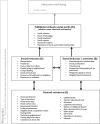Social frailty in older adults: a scoping review
- PMID: 28936141
- PMCID: PMC5587459
- DOI: 10.1007/s10433-017-0414-7
Social frailty in older adults: a scoping review
Abstract
Social frailty is a rather unexplored concept. In this paper, the concept of social frailty among older people is explored utilizing a scoping review. In the first stage, 42 studies related to social frailty of older people were compiled from scientific databases and analyzed. In the second stage, the findings of this literature were structured using the social needs concept of Social Production Function theory. As a result, it was concluded that social frailty can be defined as a continuum of being at risk of losing, or having lost, resources that are important for fulfilling one or more basic social needs during the life span. Moreover, the results of this scoping review indicate that not only the (threat of) absence of social resources to fulfill basic social needs should be a component of the concept of social frailty, but also the (threat of) absence of social behaviors and social activities, as well as (threat of) the absence of self-management abilities. This conception of social frailty provides opportunities for future research, and guidelines for practice and policy.
Keywords: Scoping review; Social frailty; Social needs; Social vulnerability.
Conflict of interest statement
The authors declare that they have no conflict of interest.
Figures


Similar articles
-
Giving voice to older adults living with frailty and their family caregivers: engagement of older adults living with frailty in research, health care decision making, and in health policy.Res Involv Engagem. 2016 Jun 17;2:23. doi: 10.1186/s40900-016-0038-7. eCollection 2016. Res Involv Engagem. 2016. PMID: 29062523 Free PMC article. Review.
-
Identifying models of care to improve outcomes for older people with urgent care needs: a mixed methods approach to develop a system dynamics model.Health Soc Care Deliv Res. 2023 Sep;11(14):1-183. doi: 10.3310/NLCT5104. Health Soc Care Deliv Res. 2023. PMID: 37830206 Review.
-
Interventions to prevent or reduce the level of frailty in community-dwelling older adults: a protocol for a scoping review of the literature and international policies.BMJ Open. 2016 Mar 2;6(3):e010959. doi: 10.1136/bmjopen-2015-010959. BMJ Open. 2016. PMID: 26936911 Free PMC article.
-
Trends in the Assessment of Social Frailty in Community-Dwelling Older Adults: A Scoping Review.Cureus. 2024 Aug 10;16(8):e66614. doi: 10.7759/cureus.66614. eCollection 2024 Aug. Cureus. 2024. PMID: 39258050 Free PMC article.
-
Toward the development of a vibrant, super-aged society: The future of medicine and society in Japan.Geriatr Gerontol Int. 2021 Aug;21(8):601-613. doi: 10.1111/ggi.14201. Epub 2021 Jul 1. Geriatr Gerontol Int. 2021. PMID: 34212470
Cited by
-
Prevalence of social frailty and its associated factors in the older Chinese population: a national cross-sectional study.BMC Geriatr. 2023 Sep 1;23(1):532. doi: 10.1186/s12877-023-04241-1. BMC Geriatr. 2023. PMID: 37658332 Free PMC article.
-
Impact of Social Frailty in Hospitalized Elderly Patients With Heart Failure: A FRAGILE-HF Registry Subanalysis.J Am Heart Assoc. 2021 Sep 7;10(17):e019954. doi: 10.1161/JAHA.120.019954. Epub 2021 Sep 2. J Am Heart Assoc. 2021. PMID: 34472374 Free PMC article.
-
Defining and assessing psychological frailty in older adults: a scoping review protocol.BMJ Open. 2024 Mar 4;14(3):e080179. doi: 10.1136/bmjopen-2023-080179. BMJ Open. 2024. PMID: 38443084 Free PMC article.
-
Factors Affecting Medication Adherence in Middle-Aged and Elderly Patients in China: A Cross-Sectional Study.Med Sci Monit. 2025 Jan 23;31:e945805. doi: 10.12659/MSM.945805. Med Sci Monit. 2025. PMID: 39844448 Free PMC article.
-
Prognostic impact of multi-domain approaches and the Tilburg frailty indicator in elderly patients with heart failure.Aging Clin Exp Res. 2025 Jul 19;37(1):225. doi: 10.1007/s40520-025-03121-5. Aging Clin Exp Res. 2025. PMID: 40682694 Free PMC article.
References
-
- Andrew MK, Rockwood K. Social vulnerability predicts cognitive decline in a prospective cohort of older Canadians. Alzheimers Dement. 2010;6(319–325):e1. - PubMed
Publication types
LinkOut - more resources
Full Text Sources
Other Literature Sources
Medical
Research Materials

